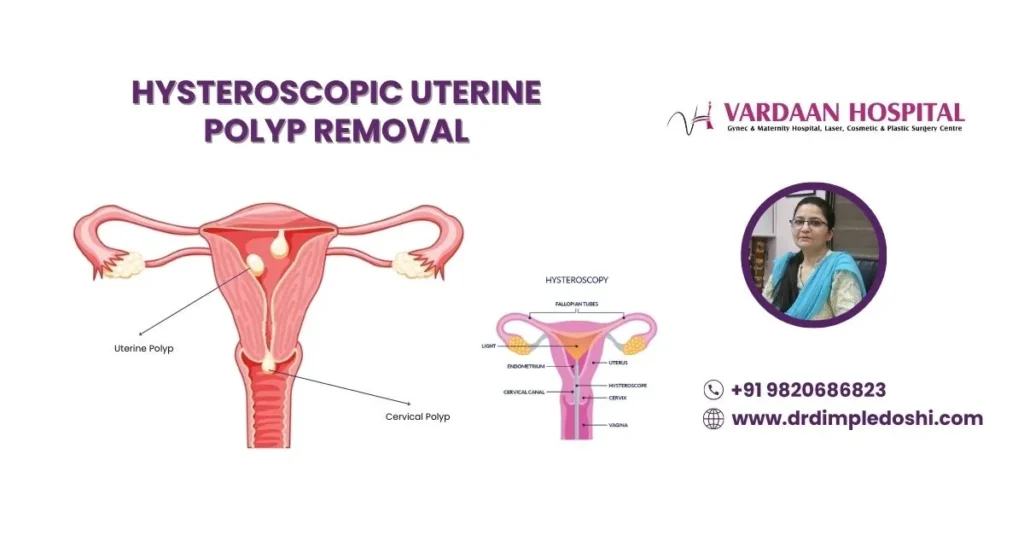Hysteroscopic Uterine Polyp Removal: Procedure, Indications, and Recovery

What is Hysteroscopic Uterine Polyp Removal?
Hysteroscopic uterine polyp removal is a minimally invasive, daycare procedure used to remove polyps from the uterus using hysteroscopy. Uterine polyps are overgrown tissues inside the uterus. While most polyps are noncancerous, a small percentage can be precancerous or cancerous. These polyps are more common as women age, particularly in post-menopausal women.
Indications for Uterine Polyp Removal
Most women with uterine polyps are unaware of their presence until they are discovered during routine screenings or evaluations for other medical conditions. Common reasons for polyp removal include:
- Large Polyps: Causing symptoms such as heavy menstrual bleeding or abnormal vaginal discharge.
- Infertility Concerns: Removal is often recommended for women seeking fertility treatments.
- Post-Menopausal Bleeding: Any bleeding after menopause due to polyps should be investigated.
- Heavy Menstrual Bleeding: Polyps of any size contributing to heavy bleeding should be removed.
Preoperative Preparations for Hysteroscopic Uterine Polyp Removal
To ensure a safe and smooth procedure, the following preoperative steps are typically recommended:
- Medical Tests: Carry all investigation reports, including complete blood count, liver function, thyroid, kidney function tests, chest X-ray, and other preoperative evaluations.
- Medication Adjustments: Discontinue estrogen-containing medications one month prior and blood thinners (e.g., aspirin) at least one week before the procedure. Continue thyroid, blood pressure, and diabetes medications unless otherwise instructed.
- Report Illness: Inform your doctor if you experience any signs of illness before the procedure.
Hysteroscopic Uterine Polyp Removal Procedure
This procedure is performed under general anesthesia and follows these steps:
- Uterine Distension: The uterus is expanded using normal saline.
- Hysteroscope Insertion: A thin hysteroscope is inserted through the cervix to visualize the polyp.
- Polyp Removal: The polyp is excised using tiny hysteroscopic scissors and removed with a hysteroscopic grasper. Alternative methods may involve loop electrodes and high-frequency electrosurgical energy.
Postoperative Care and Recovery
- Immediate Recovery: You will be monitored in a recovery room for about two hours after awakening from anesthesia. It is normal to feel drowsy or fatigued for several hours.
- Diet: Clear liquids are typically started one hour after surgery, followed by a light diet.
- Activity: You will be encouraged to walk once the effects of anesthesia wear off. You may be discharged once you can walk without dizziness.
When to Contact Your Doctor
Seek immediate medical attention if you experience:
- Persistent or worsening pain
- Nausea and vomiting
- Other unusual symptoms
Potential Complications of Hysteroscopic Uterine Polyp Removal
As with any surgical procedure, there are risks and potential complications, including:
- Anesthesia-Related Issues: Allergic reactions or side effects from anesthesia.
- Organ Injury: Potential injury to surrounding internal organs.
- Bleeding and Infection: Though rare, these are possible complications.
Your doctor will discuss all specific risks and complications with you before the procedure to ensure you are well-informed.
Frequently Asked Questions (FAQs)
Q1. Is hysteroscopy polyp removal painful?
Ans. Hysteroscopic polyp removal is done under short general anesthesia. So no pain during the procedure but mild discomfort following the procedure.
Q2. What is the recovery time for hysteroscopy polyp removal?
Ans. One can be discharged the same day and can start normal activities the same day.
Q3. How does hysteroscopy remove uterine polyp?
Ans. Through hysteroscopy; the inner uterine cavity is visualised and the polyp is excised using hysteroscopic scissors.
Q4. Is uterine polyp removal major surgery?
Ans. No ; hysteroscopic uterine polyp surgery is a minimally invasive procedure and not a major surgery;
Q5. How many days rest is required after hysteroscopy?
Ans. Hysteroscopy is a day care procedure and no extra rest is required.
Q6. What are the side effects of a hysteroscopy? Do you get stitches with a hysteroscopy?
Ans. Hysteroscopy is done by introducing a hysteroscope introduced through vagina. One does not get any stitches with hystersocopy.
Q7. Can polyps come back after hysteroscopy?
Ans. Yes; polyps can come back after their removal though recurrence rate is low and if it does happen; further treatment is necessary.
Q8. Can you bleed after polyp removal?
Ans. Yes; it is normal to bleed for 3 to 4 days following hysteroscopic polyp removal.
Q9. Can uterus polyps be removed without surgery?
Ans. Small uterine polyps may resolve on their own but otherwise surgical removal is the option.
Q10. Does hysteroscopy need anesthesia?
Ans. Hysteroscopy can be done in local anesthesia but if pain is the concern and procdure like multiple polyp removal is to be done simultaneously; its better to do get it done under short sedation ; the effect of which wears off immediately after the procedure gets over.

